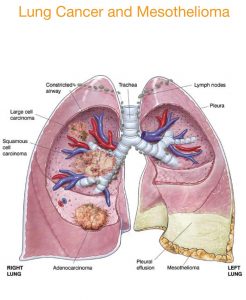What is Mesothelioma?
Mesothelioma is a cancer caused by asbestos and is not related to smoking. When inhaled asbestos fibres can penetrate the lung causing cancer in the lining of the lung (pleura), or penetrate the bowel or stomach causing cancer in the lining of the abdomen (peritoneum).
It is thought that the incidence of mesothelioma in Australia will not peak until sometime between 2015 and 2020 and beyond. Asbestos is the only known cause of mesothelioma in Australia.
Mesothelioma is an incurable malignancy which affects the parietal layer (lining) of the pleura. It may also affect the abdominal cavity (the peritoneum). The majority of cases affect the pleura. As the disease progresses the pleura or the peritoneum thickens from the calibre of a cigarette paper to form a hard tumour mass often between 0.5 and 1.0 em thick. This tissue compresses the lung and the lung and gastrointestinal tract. This may cause intestinal obstruction.

The above graph is based on figures contained in the Australian Safety & Compensation Council report “Mesothelioma in Australia – Incidence 1982 to 2004” dated March 2008
Cigarette smoking is not related to the development of mesothelioma. Exposure to Erionite, a fibrous mineral found in Turkey, may also cause mesothelioma.
 Mesothelioma is the most lethal of all asbestos disease. Unfortunately it is also one of the most prevalent. Of claims filed in the Dust Diseases Tribunal of NSW, a specialist court handling asbestos compensation claims, mesothelioma claims historically account for approximately fifty per cent of total claims filed.
Mesothelioma is the most lethal of all asbestos disease. Unfortunately it is also one of the most prevalent. Of claims filed in the Dust Diseases Tribunal of NSW, a specialist court handling asbestos compensation claims, mesothelioma claims historically account for approximately fifty per cent of total claims filed.
The latency period between first exposure to asbestos and the onset of mesothelioma is rarely less than 20 years from first exposure and may be more than 50 years. Diagnosis of mesothelioma is usually made by biopsy by either a needle biopsy or through key-hole surgery.
Of the various commercial types of asbestos, mesothelioma is predominantly associated with exposure to the blue asbestos, crocidolite and brown asbestos, amosite. White asbestos, chrysotile has also been linked to the incidence of mesothelioma. All asbestos exposure should be avoided given the potential of developing mesothelioma which is also often associated with quite brief or low level of asbestos exposure.
Mesothelioma Symptoms, Diagnosis, Treatment, Life Expectancy
Shortness of breath, which is frequently associated with the collection of fluid in the plaural space (a pleural effusion), is treated by a procedure called a VATS pleurodesis. During this procedure, the surgeon obtains a biopsy and can perform a pleurodesis. This prevents fluid accumulating in the leural space in the future. The patient can then be fairly confident that any further breathlessness will not be related to re-accumulation of pleural fluid.
Recently there has been some progress in the treatment of mesothelioma particularly with the chemotherapy drug Alimta which has been found to extend life expectancy in some cases. Some people who have been treated with Alimta are still alive years after diagnosis with mesothelioma. Other treatments are also being trial led.
Another option for treatment of mesothelioma is a pleuropneumonectomy which is the surgical removal of the lung, the pleura and the diaphragm. It is a major operation. Whether it extends life span is unclear.’ Recently there has been an increased effort to find a cure for mesothelioma and an example of this is the establishment of the Asbestos Diseases Research Institute in Sydney.
The Australian Mesothelioma Registry (AMR)
The AMR includes information about each person diagnosed with mesothelioma on or after 1st July 2010 in Australia. AMAA encourages participation in the AMR which involves completing a postal questionnaire with information about residential, school and occupational histories. Patients are also asked about their family history of mesothelioma. This is followed by a telephone interview tailored to the participant. The information collected is used to assess the participant’s past exposure to asbestos throughout their lifetime. This will help the Australian Government develop policies to best deal with the asbestos still present in Australia’s buildings and environment and to prevent mesothelioma in the future.
If you are a mesothelioma patient or a medical professional and are approached to participate in the AMR, we encourage you to be become involved. More information about the AMR is available on their website: http://www.mesothelioma-australia.com/.
How can AMAA help you
For more information on the symptoms, treatments and management of Mesothelioma, please get in touch with the Asbestosis and Mesothelioma Association of Australia (AMAA) on 1800 017 758 or via our contact us form today.